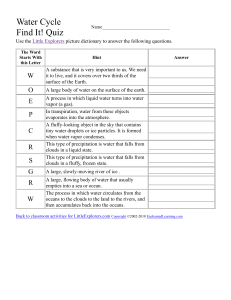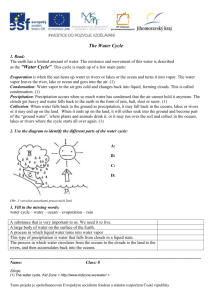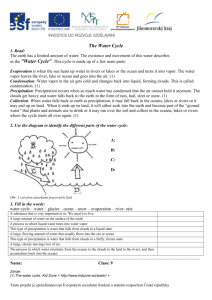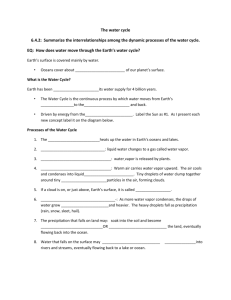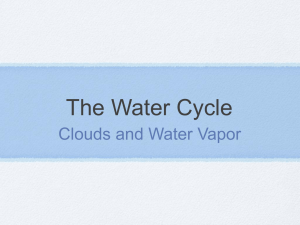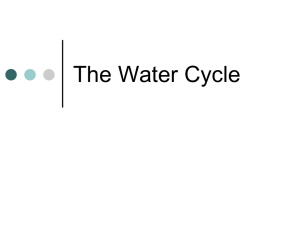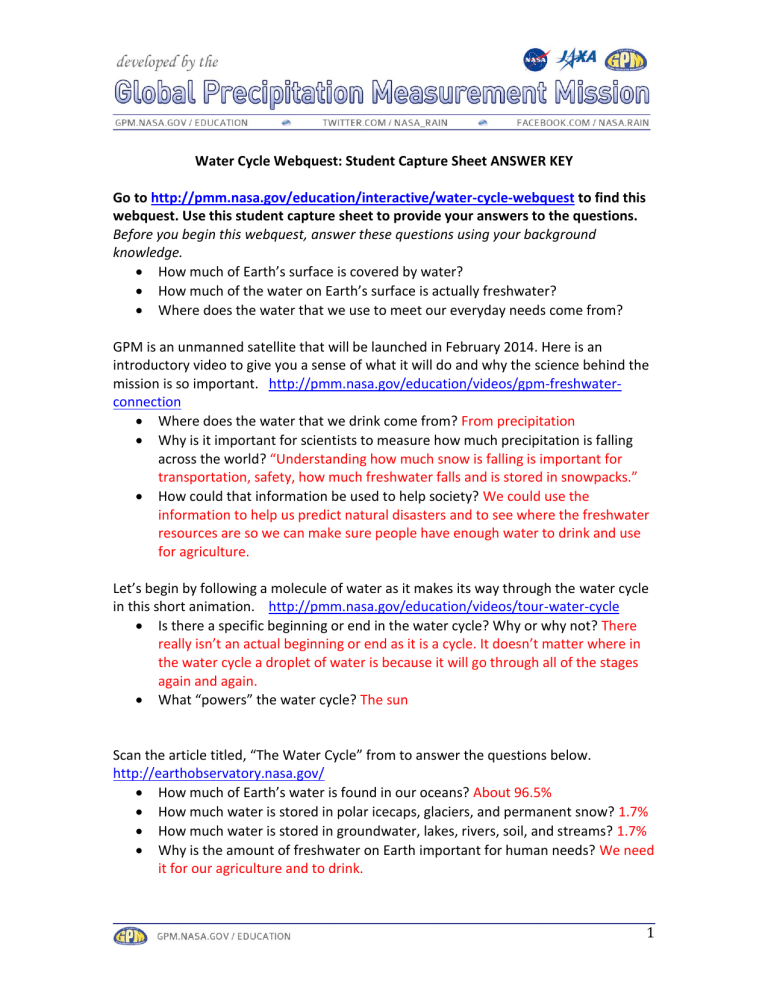
Water Cycle Webquest: Student Capture Sheet ANSWER KEY Go to http://pmm.nasa.gov/education/interactive/water-cycle-webquest to find this webquest. Use this student capture sheet to provide your answers to the questions. Before you begin this webquest, answer these questions using your background knowledge. How much of Earth’s surface is covered by water? How much of the water on Earth’s surface is actually freshwater? Where does the water that we use to meet our everyday needs come from? GPM is an unmanned satellite that will be launched in February 2014. Here is an introductory video to give you a sense of what it will do and why the science behind the mission is so important. http://pmm.nasa.gov/education/videos/gpm-freshwaterconnection Where does the water that we drink come from? From precipitation Why is it important for scientists to measure how much precipitation is falling across the world? “Understanding how much snow is falling is important for transportation, safety, how much freshwater falls and is stored in snowpacks.” How could that information be used to help society? We could use the information to help us predict natural disasters and to see where the freshwater resources are so we can make sure people have enough water to drink and use for agriculture. Let’s begin by following a molecule of water as it makes its way through the water cycle in this short animation. http://pmm.nasa.gov/education/videos/tour-water-cycle Is there a specific beginning or end in the water cycle? Why or why not? There really isn’t an actual beginning or end as it is a cycle. It doesn’t matter where in the water cycle a droplet of water is because it will go through all of the stages again and again. What “powers” the water cycle? The sun Scan the article titled, “The Water Cycle” from to answer the questions below. http://earthobservatory.nasa.gov/ How much of Earth’s water is found in our oceans? About 96.5% How much water is stored in polar icecaps, glaciers, and permanent snow? 1.7% How much water is stored in groundwater, lakes, rivers, soil, and streams? 1.7% Why is the amount of freshwater on Earth important for human needs? We need it for our agriculture and to drink. 1 Next, click on “A Multi-Phased Journey” at the bottom of the page, and use that information to do the following: Look at the diagram of the hydrologic cycle, and use it to help you to write a paragraph that explains how a droplet of water that falls as rain can move through the atmosphere, the biosphere, the geosphere, and the hydrosphere. Be specific as you explain the processes (evaporation, condensation, transpiration) that occur because of interaction between Earth’s spheres. In your response, be sure to Give the state of matter that water is in as it moves through Earth’s systems Describe what processes occur to change water from one state of matter to another Explain how interactions between Earth’s spheres keep water cycling between them Example of a thorough response: A droplet of water falls to the Earth as rain as it moves through Earth’s atmosphere, biosphere, geosphere, and hydrosphere. As precipitation is a form of water, it is part of the hydrosphere, as all water on Earth; solid like ice, liquid like rain, or in a gas like water vapor; are part of Earth’s hydrosphere. The droplet of water is in the liquid form as it falls through Earth’s atmosphere, which is the blanket of gases surrounding Earth. If it falls onto a farmer’s crops, then it provides water to help the crops grow. The crops are part of the biosphere, which includes the living things on Earth. When people eat the crops, then that water also goes into another part of the biosphere. When the sun shines and adds heat to the geosphere, Earth’s land surfaces, the water droplet may get so hot that it evaporates into water vapor, and is now a gas. This also will happen to the water that is in the crops when it gets hot enough, and it will turn into water vapor, in a process known as “transpiration”. Now the water, in the form of a gas, has evaporated into the atmosphere. As the water vapor comes together, clouds may be formed, and the water becomes liquid or solid as the temperatures decrease. Clouds form, and eventually gravity causes the water to fall back to Earth in the form of a solid; as hail, sleet, or snow; or as a liquid, as rain. The same water will continually cycle through Earth’s atmosphere, geosphere, and biosphere in the forms of a liquid, a gas, or a soliddepending on the temperature. Let’s learn more about how our water cycle is able to distribute both water and heat as it moves through the water cycle: http://pmm.nasa.gov/education/videos/earths-watercycle. 2 Where is more than two-thirds of Earth’s freshwater stored? in Earth’s polar ice caps, snow packs, or glaciers Why is there more evaporation in the tropics? The ocean temperatures are warmer there, and thus more water is evaporated Why do you think that clouds and water vapor act like “insulators” from the sun”? The water vapor makes up the clouds, and the clouds help to shield the Earth from the Sun, and trap the heat from below. What are two things that water variability affects for us? 1. The type and amount of vegetation, which is the primary source of food for people and animals. 2. Causing extremes, such as droughts or floods, which can result in both economic and human losses At this website, http://pmm.nasa.gov/education/videos/water-cycle-heating-ocean, you will find out more about how the oceans impact the water cycle. How are the land, air, and water heated each day? They absorb sunlight and are heated. Look at the second animation. Explain the differences that the data shows between the heating of the land and the water during the day and night cycle. The land surfaces get warmer after the sun rises, and cool off fairly quickly after the sun sets, while the ocean surface temperature doesn’t vary much at all from day to night. Look at the third animation. Explain how the movement of warm currents might affect the climate in Florida. The climate in Florida will be warmer than other parts of the US throughout the entire year because the warm tropical water is being pushed toward Florida throughout the seasons. The next website will focus on how evaporation and winds combine to move water from the oceans to the land. http://pmm.nasa.gov/education/videos/water-cycle-steamingair How does the ocean lose water to the air? Water from the ocean evaporates into the air Why doesn’t the water vapor just stay over the ocean? Winds spread the water vapor across the globe Why don’t the oceans simply reabsorb the water that evaporates? The water vapor is moved by the winds and ends up over other parts of the world Why does more water evaporate off of oceans than off of land? Because the oceans cover almost 75% of the Earth’s surface, so there is a lot more ocean water than water on land to evaporate About how long does water vapor remain in the air? An average of 10 days 3 As you watch the animations depicting wind and evaporation data over the world, describe what you notice about the patterns the winds and clouds follow: Do clouds and wind appear to follow the same patterns? Can you find any patterns in the direction that they move? Both the winds and the clouds move in the same directions. In the northern hemisphere between North America and Asia, the winds move from west to east near the equator, and then circulate around clockwise and move from east to west in the higher latitudes. We know that everything needs freshwater to survive. Go to this site and find the answers to these questions: http://www.epa.gov/WaterSense/our_water/water_use_today.html Where does the freshwater that you use in your home come from? From precipitation About how much water does the average American family of four use per day in their home? About 300 gallons What percentage of water do we use for washing our clothing? 21.7% What percentage of water do we use for flushing our toilets? 26.7% Look at the pie graph depicting how freshwater is used for industrial, agricultural, and electric water use, and use that information to answer these questions. What percentage more of water is used to provide us with electricity versus for irrigation? 41.5 – 37 = 4.5% more Do we use more freshwater in our homes or to provide us with electricity? We use a lot more freshwater, about 41.5%, to provide us with electricity than in our homes, which is about 8.5%. At this website, http://pmm.nasa.gov/education/videos/water-cycle-watering-land you will find out the processes of condensation and precipitation. Read the description, and then answer these questions. How do clouds form? Clouds form as water vapor rises, cools, and condenses into little water droplets. What role do clouds play in regulating Earth’s energy balance? Clouds reflect sunlight away from Earth About how much of Earth is covered by clouds at any one time? About 50% What is the ratio of water than falls on land as compared to the amount that falls onto the oceans? About 100 trillion tons of water over land compared to 400 trillion over water, so 1:4 As you watch the animations, watch the direction that the wind is blowing in. Does the direction change in different regions of the world? yes 4 How does the direction that the wind is blowing in affect how much precipitation the Eastern seaboard of the United States gets per year? There is wind blowing down from Canada as well as blowing in from the Atlantic Ocean. Both of these wind patterns converge at the Eastern seaboard, and cause a lot of precipitation to occur in this area and just off to sea in the Atlantic Ocean. Why do you think the northern part of Africa doesn’t receive very much precipitation per year? There appears to be very little ocean water vapor that gets blown over the northern part of Africa, and so it receives very little precipitation. Now sit back and enjoy this video about the water cycle and the importance of water to life on Earth. http://pmm.nasa.gov/education/videos/water-water-everywhere What is special about water as a compound? It is the only compound that can be found naturally as a liquid, gas, and solid. How does water regulate climate? By storing heat during the day and releasing it during the night, and by carrying heat from the tropics to the poles What drives water evaporation? Heat from the sun Why is the water vapor fresh water when it rises from the ocean? The salt stays behind in the ocean Why might freshwater in the form of snow take longer to enter the water cycle again than liquid precipitation? It may stay locked in a glacier or an ice sheet or in the soil for a long period of time. What is an aquifer? Any underground storage area for water What role do people play in the water cycle? Pumping water out of the ground for irrigation, cutting down forests for development, and building roads, when we control the water after it has fallen, putting in dams 5
